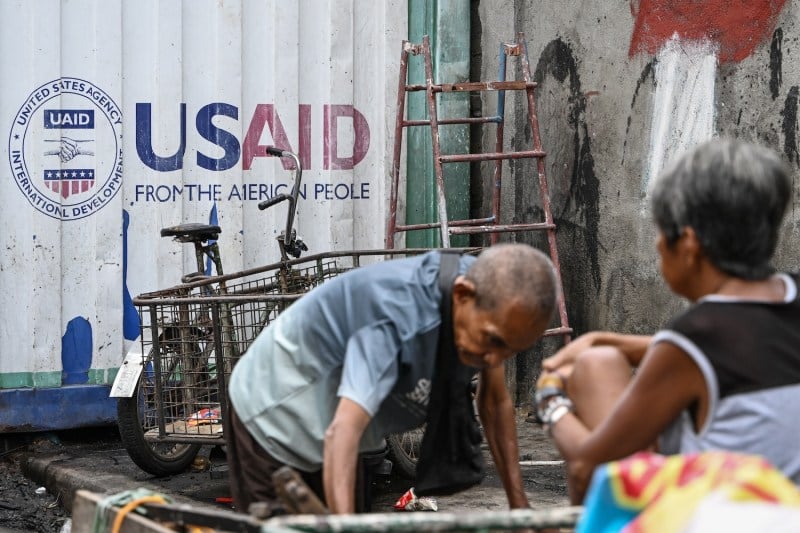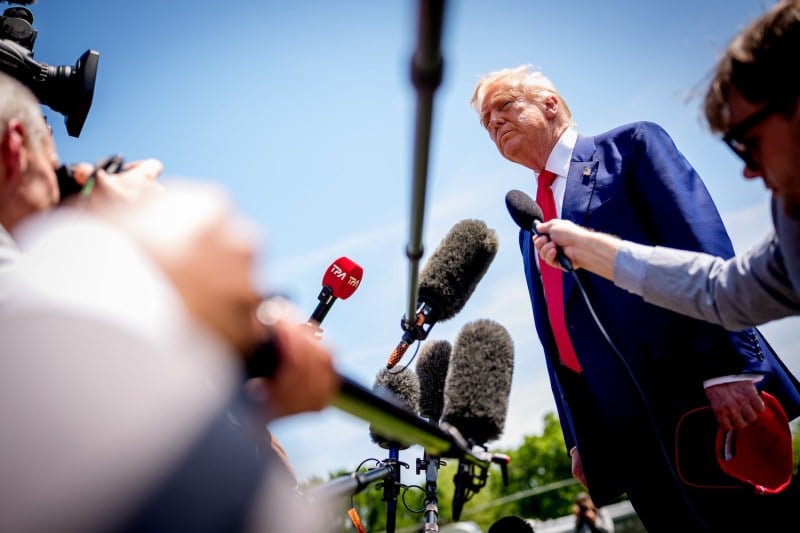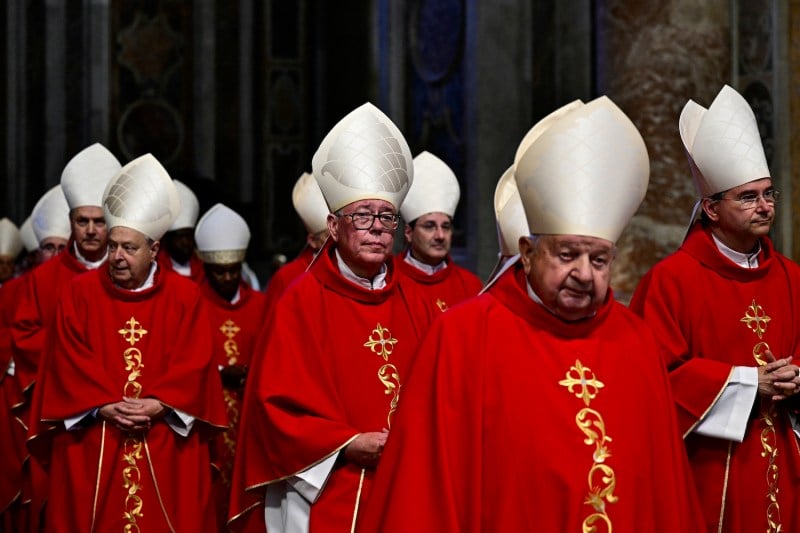What Trump’s New Budget Says About U.S. Foreign Policy

What Trump’s New Budget Says About U.S. Foreign Policy
The president wants to significantly pull back on many of America’s traditional global engagements while spending more on the border and defense.
Signage for the U.S. Agency for International Development is seen on a cargo container beyond people sorting through salvageable items to be sold to junk shops in Manila, Philippines, on Feb. 4. Jam Sta Rosa / AFP via Getty Images
U.S. President Donald Trump unveiled his budget proposal for the upcoming fiscal year in a letter to Congress on Friday, providing the clearest picture yet of what his administration will prioritize and putting some numbers on the large-scale slashing of the federal government that he has overseen. The budget aims to cut $163 billion in nondefense spending, a 22.6 percent reduction from current levels, the letter said.
Trump’s “America First” agenda means that many of the biggest cuts impact U.S. foreign policy, particularly at the State Department and the U.S. Agency for International Development (USAID)—the latter of which Trump and his billionaire advisor Elon Musk all but gutted. At the same time, Trump is allocating more than $113 billion to the Defense Department and $43.8 billion for the Department of Homeland Security to bolster Trump’s border security proposals and controversial mass deportations.
U.S. President Donald Trump unveiled his budget proposal for the upcoming fiscal year in a letter to Congress on Friday, providing the clearest picture yet of what his administration will prioritize and putting some numbers on the large-scale slashing of the federal government that he has overseen. The budget aims to cut $163 billion in nondefense spending, a 22.6 percent reduction from current levels, the letter said.
Trump’s “America First” agenda means that many of the biggest cuts impact U.S. foreign policy, particularly at the State Department and the U.S. Agency for International Development (USAID)—the latter of which Trump and his billionaire advisor Elon Musk all but gutted. At the same time, Trump is allocating more than $113 billion to the Defense Department and $43.8 billion for the Department of Homeland Security to bolster Trump’s border security proposals and controversial mass deportations.
Defense spending overall would go up to $1.01 trillion, a 13 percent increase from 2025 levels.
The budget proposal—which you can read in full here—does not equal concrete policy and is still subject to approval (and adjustments) from Congress, but it serves as a key indicator of how Trump sees the United States’ role in the world.
State Department and USAID
Under the new budget, the State Department and other international programs would take the biggest cut at a whopping 83.9 percent ($49.1 billion). That includes a cut of $8.33 billion for development, democracy, and economic aid, which the administration describes as “having been funneled to radical, leftist priorities, including climate change, diversity, equity, and inclusion (DEI), and LGBTQ activities around the world.”
Since Trump took office, the State Department has already frozen or slashed funding for many of these programs. The budget also proposes a $3.2 billion cut in international disaster relief aid, which the administration describes as previously being at “unaffordable levels.”
Those are just two of 15 total cuts that the Trump administration is proposing to State Department and other international programs, with others affecting peacekeeping missions, educational and cultural exchanges, funding for the World Health Organization and other international organizations, and funding for the National Endowment for Democracy.
At the same time, the budget boosts spending in a couple of Trump-approved areas. It allocates $2.9 billion to an America First Opportunity Fund, which would “focus on strategic investments that make America safer, stronger, and more prosperous.” The description of the fund is vague but calls for supporting Jordan, India, and other “critical partners” and countering “China and other near-peer rivals.” The fund is described as one of the tools to replace traditional development aid.
It also allocates $2.82 billion for the U.S. International Development Finance Corporation (DFC). Created by Congress in 2018 to counter China’s Belt and Road Initiative, the DFC is essentially the United States’ development bank. The budget request reflects the argument popular among many Republicans that the DFC will “reduce reliance on foreign aid.” (Read Foreign Policy’s coverage of the DFC at its five-year mark here).
Department of Defense
Much of the proposed 13 percent increase in overall defense spending comes from $113 billion allocated directly to the Defense Department with a focus on U.S. shipbuilding, countering China’s “aggression” in the Indo-Pacific region, and creating a missile defense system dubbed the “Golden Dome for America.”
The budget does not provide a specific number for cuts to the Defense Department’s budget, but says it “ends wasteful spending of taxpayer dollars on woke climate and DEI programs.”
Department of Homeland Security
The proposal allocates $43.8 billion to “fully implement the President’s mass removal campaign” and finish construction of the border wall in the southwest, among other measures
It also cuts $491 million for the Cybersecurity and Infrastructure Security Agency (CISA), which the Trump administration says “was more focused on censorship than on protecting the Nation’s critical systems.” CISA is the primary U.S. cyberdefense agency, tasked with protecting U.S. elections and critical infrastructure from foreign adversaries such as China, Russia, and Iran.
Department of Commerce
The budget boosts funding by $134 million for fair trade. That includes new funding for anti-dumping investigations as well as $122 million for the Bureau of Industry and Security (BIS), a 50 percent increase, intended to protect U.S. technological competitiveness vs. China. That’s a sharp reversal from the $20 million cut to BIS proposed by the Trump administration for fiscal year 2025, which represented a 12 percent reduction that Senate Democrats expressed alarm about given the agency’s central role in enforcing export controls on technology—including semiconductors.
Other
- A $275 million cut to international climate work including the Global Environmental Facility and Climate Investment Funds, which the proposal says “promote woke Green New Deal” policies.
- A cut of $555 million for multilateral development banks, including the African Development Bank and other MDBs.
- A cut of $17.96 billion to the National Institutes of Health and a $3.59 billion cut for the Centers for Disease Control and Prevention (CDC), although the budget states that global public health and infectious disease surveillance will remain a CDC priority.
- An increase of $596 million in funding for the Department of Transportation’s shipbuilding and port infrastructure programs. This is part of the administration’s broader effort to counter China’s dominance of the shipbuilding industry.
- Billions in cuts to NASA programs, including space science, to instead focus on “beating China back to the Moon and putting the first human on Mars.”
- Formalized funding cuts to the U.S. Agency for Global Media (the parent organization for Voice of America and other state-funded media outlets, including Radio Free Europe and Asia), the U.S. Institute of Peace, and the Woodrow Wilson Center, among others. These organizations have been important centers of research and reporting on China, Russia, and other foreign countries. (Read FP’s reporting on the shutdown of VOA and RFA and the impact on China reporting here.)
This post is part of FP’s ongoing coverage of the Trump administration. Follow along here.
Lili Pike is a reporter at Foreign Policy. X: @lili_pike
Rishi Iyengar is a reporter at Foreign Policy. X: @Iyengarish
More from Foreign Policy
-

A drawn illustration of a Trump whirlwind on a red background Four Explanatory Models for Trump’s Chaos
It’s clear that the second Trump administration is aiming for change—not inertia—in U.S. foreign policy.
-

Marco Rubio is seen up close, sitting on a couch beside J.D. Vance. Marco Rubio’s Soulless Crusade
The U.S. secretary of state stands for no principle other than serving the man who appointed him.
-

Soldiers from various NATO allies take part in a military exercise at the Smardan Training Area in Smardan, Romania, on Feb. 19. America Will Miss Europe’s Dependence When It’s Gone
European self-reliance for security will cost U.S. jobs, profits, and influence.
-

A collage photo illustration shows Donald Trump gesturing with arms wide. In front of him are headshots of Benjamin Netanyahu and Vlodymyr Zelensky, images of immigratns and ICE police, a tattered EU flag and America First signs. Trump’s First 100 Days on the Global Stage
Ten thinkers on what to make of the opening salvo of the president’s second term.









Join the Conversation
Commenting on this and other recent articles is just one benefit of a Foreign Policy subscription.
Already a subscriber?
.
Subscribe
Subscribe
View Comments
Join the Conversation
Join the conversation on this and other recent Foreign Policy articles when you subscribe now.
Subscribe
Subscribe
Not your account?
View Comments
Join the Conversation
Please follow our comment guidelines, stay on topic, and be civil, courteous, and respectful of others’ beliefs.
Change your username |
Log out
Change your username:
CANCEL
Confirm your username to get started.
The default username below has been generated using the first name and last initial on your FP subscriber account. Usernames may be updated at any time and must not contain inappropriate or offensive language.